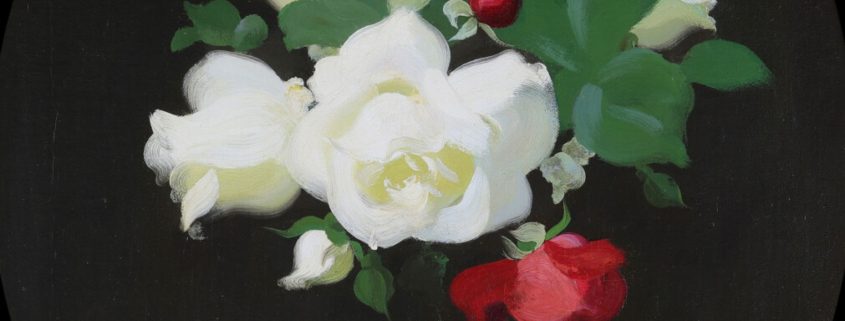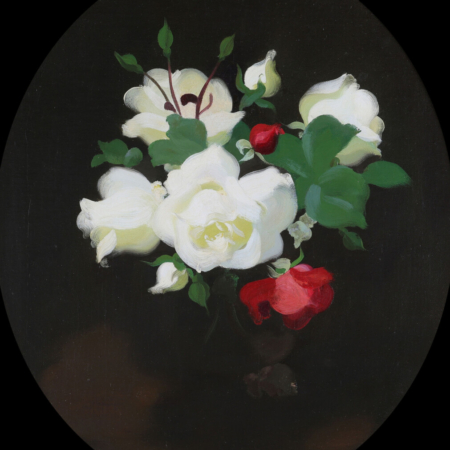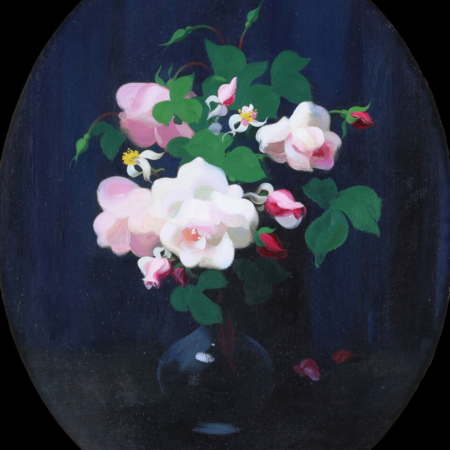
James Stuart Park
James Stuart Park lived from 1862 – 1933 and was born in Kidderminster. He lived in Glasgow from 1883 and later moved to Kilmarnock in 1904.
He studied at the Glasgow School of Art and then in Paris, at the Académie Julian with Gustave Boulanger and Jules-Joseph Lefebvre, and at the Ecole des Beaux-Arts, with Ferrnand Cormon. He started out as a portraitist but, finding it difficult to support himself, he turned to flower pieces. Painting carefully arranged bouquets of roses, lilies, orchids and azaleas he developed a very individual technique, using thick and rapid strokes against a very dark background, suggesting, rather than defining, the texture and colour of flowers.
His radically simplified style, in which the petals and flowerheads are almost abstracted and painted in rapid, cursive strokes, found favour with the Glasgow Boys and – although he was unique amongst them as almost solely a painter of flowers – he became a member of the group, along with his peers: Joseph Crawhall, E.A. Walton, Harrington Mann, George Pirie, &c (the last two of whom had also trained with Boulanger and Lefebvre).
Park worked only in Scotland, exhibiting regularly at the RSA and Glasgow Institute and exhibited rarely in England. His work became fashionable, particularly in the West of Scotland, and he was soon able to charge fairly high prices for his rapidly executed paintings.
He exhibited with the Glasgow Boys at the Royal Scottish Academy and the Royal Glasgow Institute, and worked from a studio in Glasgow until 1896, when he moved back to his home region of Kilmarnock.
The Glasgow Boys were profoundly influenced by the work of Bastien-Lepage: its naturalism, light key, and figures placed in a shallow foreground, which led them to Japanese prints with their similar use of space, and to the equally influential work of Whistler. The same interests can be seen in Stuart Park’s portraits (his Self-portrait, A gipsy maid, c.1890-95, and Dr John MacIntyre, c.1904), and in his earlier flower pieces, which are notable for their observation, their use of flat tones, shallow space or asymmetric compositions. His best work was produced in the 1880s and -90s, but even his more formulaic later work, with its undifferentiated flowers floating on a black ground, remained extremely popular with his clients. He was an accomplished watercolourist.
Works in public collections include:
Begonias, Green & yellow roses, Roses, The Hunterian Museum & Art Gallery, Glasgow; Self-portrait, Woman & roses, Red & white roses, Red & white geraniums, The Dick Institute, Kilmarnock; Orchids, Pansies, Daffodils, Dr John MacIntyre, Glasgow Museums Resource Centre.
Other examples of his work are to be found in the collection of the Lillie Art Gallery, Milngavie and Dundee City Art Galleries and Museums.
He is referred to as Stuart Park.
He died at Kilmarnock, aged 71.
He has exhibited at:
Baillie Gallery X 6
Connell and Sons Gallery X 4
Grosvenor Gallery X 2
Glasgow Institute of Fine Arts X 116
International Society X 11
Walker Art Gallery X 27
Manchester City Art Gallery X 2
Royal Academy X 1
Royal Scottish Academy X29
Royal Scottish Society of Painters in Water Colours X 2
Click on the images below to view and purchase our paintings by James Stuart Park…
- Display 24 Products per page


